
October 25, 2017; Southern Poverty Law Center
In August, the FBI released a report on the danger of what they term “Black Identity Extremists” (BIE). That same month, the Southern Poverty Law Center (SPLC), which tracks hate, also released a report on the return of the “violent Black Nationalist.”
While both the FBI and SPLC note the upward trend in Black Nationalism, the FBI report sparked outrage for piecing a few incidents together to construct a movement—which many argue does not exist—in a context where most domestic terrorism is committed by white supremacist groups, which are conspicuously off the domestic terrorist list.
The Law Center writes in its report,
Since 2000, the number of Black Nationalist groups in the United States has jumped dramatically from 48 groups to 193 in 2016. In 2007, Black Nationalism increased in response to the recent rise in White Nationalism. In 2014, another trend upward coincides with the increased media attention covering fatal police shootings of unarmed black men throughout the country.
They point to recent police murders, like these.
On July 7, 2016, Micah Xavier Johnson ambushed Dallas police officers during a peaceful protest against police brutality, killing five officers and wounding nine others. Ten days later, Gavin Eugene Long shot six officers, killing three, in Baton Rouge, Louisiana.
[…]
Johnson was later linked to Black Nationalism through his racist rhetoric and photos posted to social media. He also reportedly attempted to join a Black Nationalist group, the New Black Panther Nation (NBPN), but was ousted by NBPN leader Quanell X because of his radical views and perceived mental instability. Similarly, Gavin Long espoused antigovernment beliefs and affiliated with the Washitaw Nation, a Moorish sovereign citizen group comprised mostly of African Americans.
Sign up for our free newsletters
Subscribe to NPQ's newsletters to have our top stories delivered directly to your inbox.
By signing up, you agree to our privacy policy and terms of use, and to receive messages from NPQ and our partners.
SPLC identifies the beginning of the resurgence of Black Nationalists as “the 2014 ambush shooting deaths of two New York Police Department officers in Brooklyn, New York… [Ismaaiyl Abdullah] Brinsley boasted on social media hours earlier that he wanted to murder cops in revenge for the 2014 deaths of Michael Brown (in Ferguson, Missouri) and Eric Garner who died during a struggle with police in New York City.”
According to SPLC, while, “Black Nationalism rose in reaction to white racism during America’s civil rights era,” today’s resurgence is linked to a “rise of white supremacy since 2000 and the current Presidential administration’s perceived animosity towards Muslims.”
SPLC notes that many Black Nationalists identify as “Muslim” and claim “Islamic” teachings that promote a sense of higher purpose. They write,
Of particular concern to law enforcement, some Black Nationalists have expressed support for al-Qaeda and the Islamic State. For example, on May 4, 2017, the FBI arrested Clark Calloway—who sympathized with ISIS and wanted to start a “race war”—for unlawful possession of a machine gun. Calloway had also expressed hatred toward white people and wanted to attack law enforcement…In this respect, Black Nationalism may serve as a gateway to foreign-based extremism and international terrorism.
According to SPLC, “antigovernment, racist and religious extremist ideologies” are a “catalyst for radicalization and mobilization towards violent action for some members.” The top groups within today’s US Black Nationalist movement are the Nation of Islam, New Black Panther Party, New Black Panther Nation, New Black Liberation Militia, Five Percent Nation, Black Hebrew Israelites, and Moorish Nation.
In “Did the FBI Just Declare War on Black People,” Black political commentator Julianne Malveaux writes, “according to the Washington Post, 180 Black people have been shot and killed by police, so far, this year. Six instances of BIE folks allegedly (do we know they are BIE, or just crazy) killing police officers is a pattern, but 173 Black folks being shot by police officers is what? Business as usual?”
Foreign Policy broke the story of the FBI report on Black Identity Extremists, in which it identified the August 2014 shooting of Michael Brown in Ferguson as the catalyst for this “movement,” apparently in agreement with SPLC that these acts are a response to police shootings of unarmed black men.
Further concerns about the FBI report range “from civil rights issues to political bias to institutional incompetence.” SPLC is concerned about these as well. The merging of various hate groups under the banner of a domestic terrorist movement causes confusion and easily leads to the inclusion of black activists like Black Lives Matter who have a right to protest.
SPLC concludes, “The FBI’s attempt to lump various, disparate black extremists together under one umbrella movement does not appear factual. And, it may actually inflate the threat from violent black nationalists at the expense of other, larger, and more serious domestic extremist movements within the U.S., such as white supremacy and sovereign citizens which number in the hundreds of thousands of members.”—Cyndi Suarez











